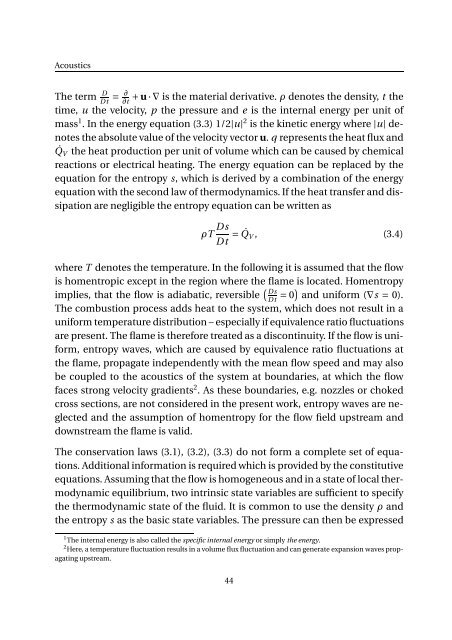Impact of fuel supply impedance and fuel staging on gas turbine ...
Impact of fuel supply impedance and fuel staging on gas turbine ...
Impact of fuel supply impedance and fuel staging on gas turbine ...
Create successful ePaper yourself
Turn your PDF publications into a flip-book with our unique Google optimized e-Paper software.
Acoustics<br />
The term D Dt = ∂ + u·∇ is the material derivative. ρ denotes the density, t the<br />
∂t<br />
time, u the velocity, p the pressure <str<strong>on</strong>g>and</str<strong>on</strong>g> e is the internal energy per unit <str<strong>on</strong>g>of</str<strong>on</strong>g><br />
mass 1 . In the energy equati<strong>on</strong> (3.3) 1/2|u| 2 is the kinetic energy where|u| denotes<br />
the absolute value <str<strong>on</strong>g>of</str<strong>on</strong>g> the velocity vector u. q represents the heat flux <str<strong>on</strong>g>and</str<strong>on</strong>g><br />
˙Q V the heat producti<strong>on</strong> per unit <str<strong>on</strong>g>of</str<strong>on</strong>g> volume which can be caused by chemical<br />
reacti<strong>on</strong>s or electrical heating. The energy equati<strong>on</strong> can be replaced by the<br />
equati<strong>on</strong> for the entropy s, which is derived by a combinati<strong>on</strong> <str<strong>on</strong>g>of</str<strong>on</strong>g> the energy<br />
equati<strong>on</strong> with the sec<strong>on</strong>d law <str<strong>on</strong>g>of</str<strong>on</strong>g> thermodynamics. If the heat transfer <str<strong>on</strong>g>and</str<strong>on</strong>g> dissipati<strong>on</strong><br />
are negligible the entropy equati<strong>on</strong> can be written as<br />
ρT Ds<br />
Dt = ˙Q V , (3.4)<br />
where T denotes the temperature. In the following it is assumed that the flow<br />
is homentropic except in the regi<strong>on</strong> where the flame is located. Homentropy<br />
implies, that the flow is adiabatic, reversible ( Ds<br />
Dt = 0) <str<strong>on</strong>g>and</str<strong>on</strong>g> uniform (∇s = 0).<br />
The combusti<strong>on</strong> process adds heat to the system, which does not result in a<br />
uniform temperature distributi<strong>on</strong> – especially if equivalence ratio fluctuati<strong>on</strong>s<br />
are present. The flame is therefore treated as a disc<strong>on</strong>tinuity. If the flow is uniform,<br />
entropy waves, which are caused by equivalence ratio fluctuati<strong>on</strong>s at<br />
the flame, propagate independently with the mean flow speed <str<strong>on</strong>g>and</str<strong>on</strong>g> may also<br />
be coupled to the acoustics <str<strong>on</strong>g>of</str<strong>on</strong>g> the system at boundaries, at which the flow<br />
faces str<strong>on</strong>g velocity gradients 2 . As these boundaries, e.g. nozzles or choked<br />
cross secti<strong>on</strong>s, are not c<strong>on</strong>sidered in the present work, entropy waves are neglected<br />
<str<strong>on</strong>g>and</str<strong>on</strong>g> the assumpti<strong>on</strong> <str<strong>on</strong>g>of</str<strong>on</strong>g> homentropy for the flow field upstream <str<strong>on</strong>g>and</str<strong>on</strong>g><br />
downstream the flame is valid.<br />
The c<strong>on</strong>servati<strong>on</strong> laws (3.1), (3.2), (3.3) do not form a complete set <str<strong>on</strong>g>of</str<strong>on</strong>g> equati<strong>on</strong>s.<br />
Additi<strong>on</strong>al informati<strong>on</strong> is required which is provided by the c<strong>on</strong>stitutive<br />
equati<strong>on</strong>s. Assuming that the flow is homogeneous <str<strong>on</strong>g>and</str<strong>on</strong>g> in a state <str<strong>on</strong>g>of</str<strong>on</strong>g> local thermodynamic<br />
equilibrium, two intrinsic state variables are sufficient to specify<br />
the thermodynamic state <str<strong>on</strong>g>of</str<strong>on</strong>g> the fluid. It is comm<strong>on</strong> to use the density ρ <str<strong>on</strong>g>and</str<strong>on</strong>g><br />
the entropy s as the basic state variables. The pressure can then be expressed<br />
1 The internal energy is also called the specific internal energy or simply the energy.<br />
2 Here, a temperature fluctuati<strong>on</strong> results in a volume flux fluctuati<strong>on</strong> <str<strong>on</strong>g>and</str<strong>on</strong>g> can generate expansi<strong>on</strong> waves propagating<br />
upstream.<br />
44
















